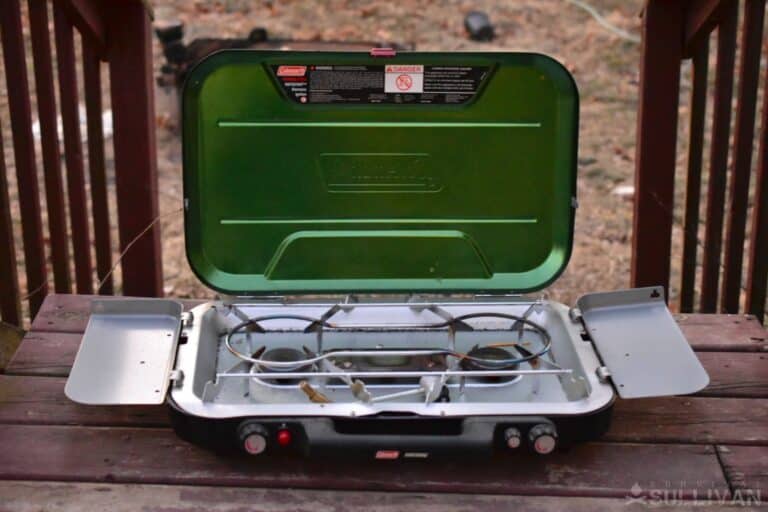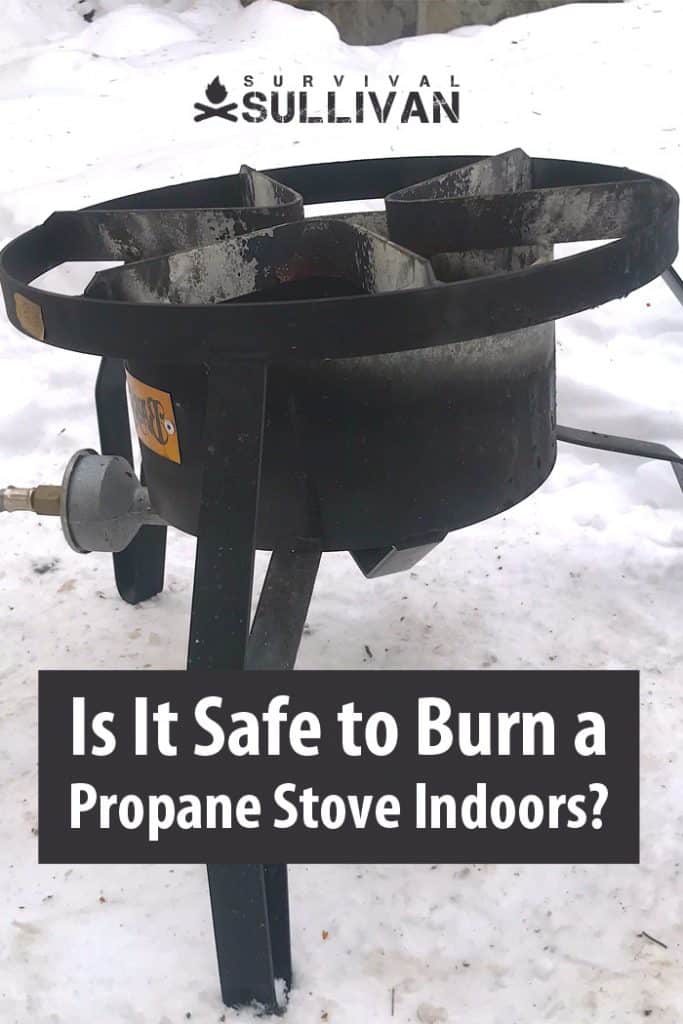One question that always seems to be bouncing around the forums and the blogs is whether or not it is safe to burn a propane stove indoors.

The answers and anecdotes vary wildly and there is no shortage of opinion stated as fact. In this article, we will look at the facts and explain the correct answer.
Is it safe to burn a propane stove indoors?
Yes, you can burn propane indoors as long as you take the proper precautions. If using a propane heater, the heater must be designed for indoor use.
Propane heaters can be rated for indoor use, outdoor use, or both. Secondly, you must have appropriate ventilation whether you are using a heater or a cookstove.
The Benefits of Using A Propane Stove Indoors
Many preppers and survivalists know the benefits of having portable propane appliances but if you’re looking to pick up a propane stove, here are some of the reasons why you should do it.
Save On Electricity Costs
If you’re using an electric stove then you’re probably using upwards of 3000 watts of power, up to 5000 watts if you’re using the oven. Obviously, propane stoves don’t use any electricity which means your hydro bill will be substantially less.
Simple To Use
Propane stoves have an ignition point and then a control for the amount of heat you want to cook with. Such simple mechanisms make it easy for repair and maintenance purposes.
Inexpensive Fuel
A propane stove uses very little propane and since it is one of the cheapest fuels around, makes for an economical choice. Portable propane stoves don’t cost anything to install and are an alternative to bring camping.
How To Use A Propane Stove While Indoors
The best case scenario is that you find an indoor propane stove with the proper certifications required to be safely used indoors.
This is usually indicative of the Underwriter’s Laboratory (UL) certification that can be found in the manufacturer’s instructions. You can also find these certifications on certain indoor propane space heater products.
Most propane stoves, however, are designed to be used outdoors and it is always wise to remember that when attempting to use it indoors.
Most propane stove either have a hose or little canisters that screw directly into the stove. Make sure you don’t cross the threads because that could cause a leak which is a fire hazard.
At a high level you want to make sure that you have good airflow, a carbon monoxide monitor and some form of fire extinguisher. Ensure you keep the propane heater far away from any combustibles such as wood or furniture made with cloth.
While using the propane stove inside check the ground in front of and underneath to ensure that there is no unwanted burning happening.
When you’re done using the propane heater make sure that the gas valve is in the off position and that all the gas has been burned off before disconnecting the tank.
The Dangers
The major concern when using a propane stove indoors is oxygen. Any type of combustion requires oxygen to burn. Of course, humans also require oxygen to breathe or risk hypoxia.
If you are in an area that is not properly ventilated and have a propane stove or heater running, the combustion taking place will pull oxygen from the air. If it depletes the oxygen level too low it could cause you to die from a lack of oxygen.
A second concern is the presence of carbon monoxide which is a colorless, odorless gas that can cause carbon monoxide poisoning which can be deadly.
A propane heater running properly will release water vapor and carbon dioxide. However, if the propane gas is not maintaining an ideal burn, the incomplete combustion will instead release carbon monoxide.
The same goes for cookstoves. If they are not burning efficiently and have incomplete combustion carbon monoxide can be released.
While one cause of an incomplete combustion process could be the absence of oxygen as mentioned before it can also be triggered by malfunctions or if the heater has not been maintained properly.
Oxygen Sensors for Heaters
Some newer propane heaters on the market are manufactured with oxygen sensors. These built-in sensors allow the heater to monitor the amount of oxygen in the air.
If the oxygen percentage drops below a pre-programmed level the heater will shut itself off.
This allows it to turn itself off and stop the flame before the incomplete combustion can begin and thereby prevents carbon monoxide from being produced.
It is important to make sure that any heater you intend to use indoors has an oxygen sensor.
Ventilation
One of the most important factors for using an indoor propane stove safely is ventilation. You must make sure that the area where the stove is operating has adequate ventilation to allow fresh air to exchange.
This provides a continuous source of oxygenated air and prevents the buildup of any carbon monoxide due to incomplete combustion.
The specific amount of ventilation is dependent on the size and style of the stove that is being operated.
You should always check the user manual for the specific stove and follow the ventilation guidelines set by the manufacturer.
One helpful way to increase ventilation is to use a fan to circulate air if one is available.
Without a fan, making sure that ventilation is available on opposite sides, rather than a single opening, will help create a cross breeze and improve air circulation.
Carbon Monoxide Detectors
A good safety net when using a propane stove or heater inside is to have a carbon monoxide detector.
Similar to a smoke detector, a carbon monoxide detector is a battery-operated device that monitors the surrounding air for the presence of the odorless, colorless gas.
This detector will sound an alarm allowing you to leave the area or better ventilate to remove the harmful gas before it builds to dangerous levels.
It is a good idea to have at least two detectors. One would be in the area the stove is operating in to detect if the stove begins emitting too much carbon monoxide.
The second would be in the lowest part of the home or area to make sure the gas doesn’t escape and collect there since carbon monoxide is lighter than air.
Popular Propane Heaters
Disclosure: This post has links to 3rd party websites, so I may get a commission if you buy through those links. Survival Sullivan is a participant in the Amazon Services LLC Associates Program. As an Amazon Associate, I earn from qualifying purchases. See my full disclosure for more.
- Mr. Heater (F232000 MH9BX) “Buddy”
- Mr. Heater (F215100 MH4B) “Little Buddy”
- Coleman Classic Propane Stove
Conclusion
When it comes to using a propane stove indoors it is safe as long as you follow some basic guidelines. Making sure you have sufficient ventilation is the key.
If you are using a heater make sure it has a low oxygen sensor. Also, make sure you have a carbon monoxide detector to alert you to in case the stove begins to produce carbon dioxide.


Born and raised in Kentucky, Steve grew up deep in the mountains on a family farm. After college, Steve spent over 15 years working in public service and has experience in Fire, EMS, and Law Enforcement. He has also worked with training and deploying search & rescue and service dogs for utilization in a variety of services.
Steve is also a Scout Leader with the Boy Scouts of America, and works to teach preparedness to the next generation. Steve has worked with and taught firearms and self-defense in multiple venues, from tactical applications to long range shooting, and also has extensive training in first aid and wilderness first aid.
An active prepper, Steve has devoted hundreds of hours to mastering and teaching skills and techniques for use in survival, homesteading, and general preparedness.
